Studio monitors are the equipment that we rely on for our creative production of music. A quality studio monitor produces the music exactly the way it is. Unlike commercial speakers, studio monitors don’t have any coloration to the sound it produces.

The accurate frequency of your mix helps you to get your mix the way you want it to be. They assist in television-radio recording, editing, and mixing for professional audio production.
Stereo speakers produce bass and punchy sound to make them sound more attractive. It makes the music or sounds more appealing, leading to the success of those speakers. But studio monitors produce the sound as much as possible, which appears to be incorrect. For playback, it is crucial to know the precise sound and frequency, which enables you to make the adjustments to want for your music.
Quality comes at a price. For the desired outcome, investment plays the role. That being said, it is also possible to find the monitors that may fit into your budgeting. You will find the right monitors that suit your home studio as well as your professional studio. This article covers the best studio monitors that do the work for the budding musicians and producers out there.
Best Studio Monitors Under $500
1.1. Presonus Eris E4.5
PreSonus Eris E4.5 is the versatile studio monitors you can go for. Even if the appearance is a downside for this monitor, the features of the speaker promises satisfied work output. With impressively flat responses and incredible transparency across the variations, this speaker is a great value for money.

It is an ideal monitor for beginners, which help them in producing quality work with not much experience in production. The speaker comes with a 1-inch tweeter and 4.5-inch Low-frequency transducers. The bass response is deep in this monitor benefits those who are into mixing. The controls of the speaker easily adjust the bass depth.
1.2 M-Audio AV42
M-Audio AV42 should be your pick if you find yourself on a tight budget. With more than average performances, these monitors are going to be a good investment of your money. Decent quality manufacturing ensures durability. The larger rear ports of the monitor make the positioning a bit of an issue.

There should be proper planning in the distance between the wall and monitor. It seems to have a bit low quality when it comes to trebles, but asking for more features in this price range may not be reasonable.
1.3 Edifier S2000 Pro (Best in design)
Rated among the best monitors you can get for this price, the Edifier S2000 tops in terms of appearance and performance. The monitor features flat diaphragm tweeters that deliver top-level frequencies.
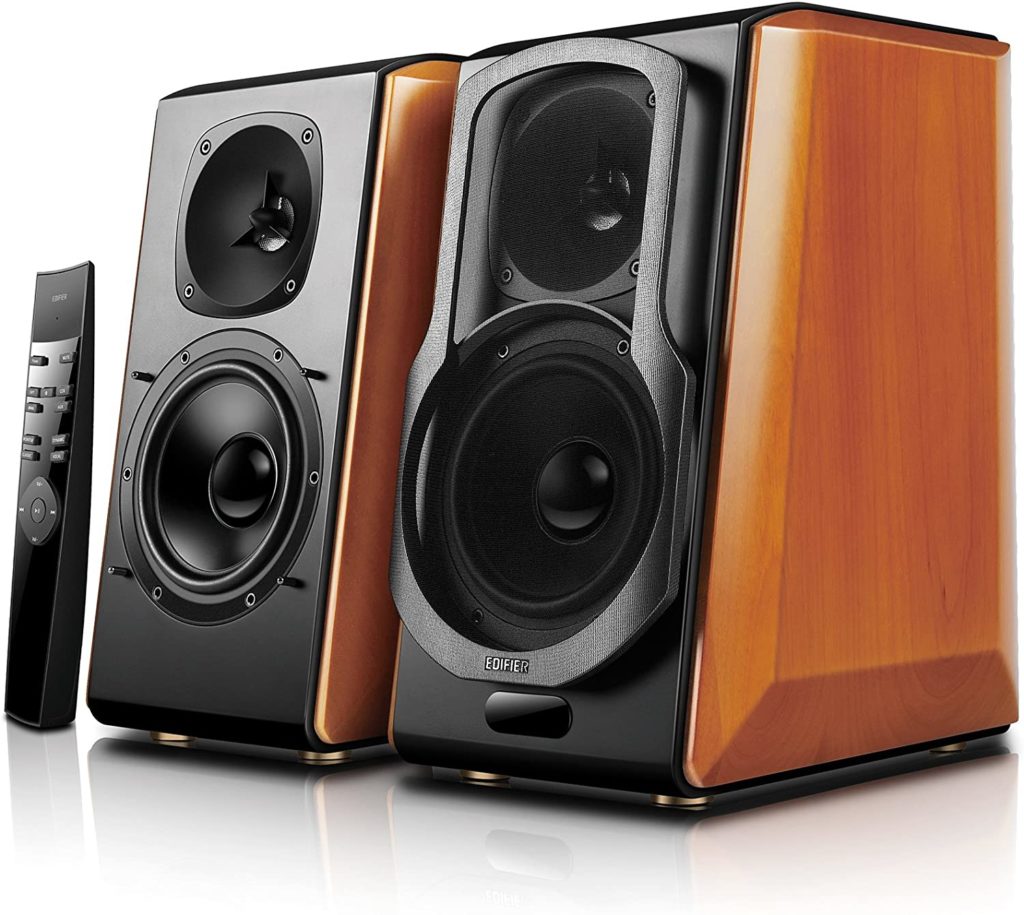
The aluminum-based woofers are effective in producing sharp and immersive sound experience. This device also comes with a handy remote control, which lets control volume, switch inputs, and numerous other functions.
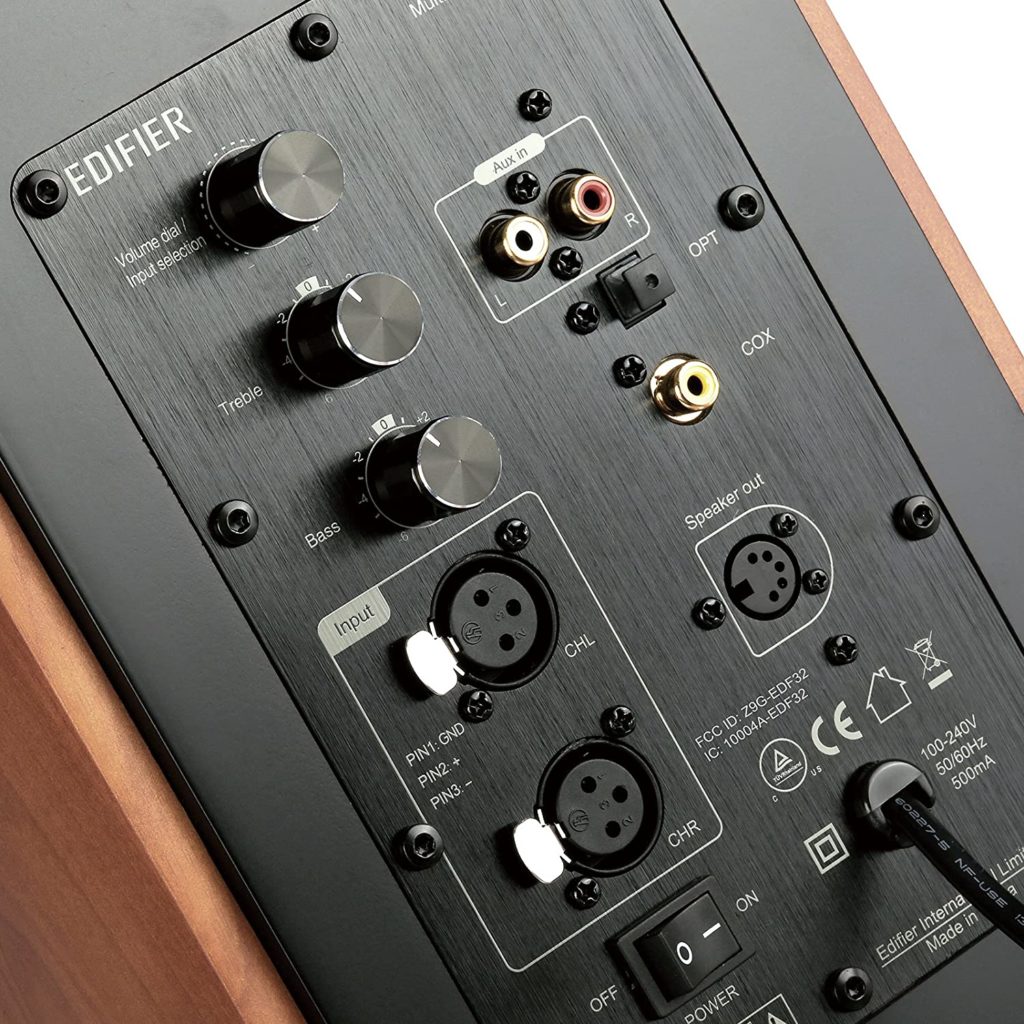
The S2000 Pro supports RCA and RCA to AUX connections, which is accessible via the coaxial or optical connections. For smoother connectivity options to a mixer, the monitor includes two XLR ports on the rear panel. With dimensions measuring 5.5 inches, this monitor adds up to the aesthetic vibes of your wood cabinet.
1.4 Genelec 8010A (Best mid-range near field monitor)
Another promising studio monitor under $500 is the Genelec 8010A. The monitor is small with 3 inches of a woofer and 0.75 inches of a tweeter. Despite the miniature size, it comes in, the monitor is solid and stands tall against damages. With a maximum output of around 96db SPL, the 8010A carries the best response rate.


Best Studio Monitors Under $200
2.1 Rockville APM8W
Rockville APM8W is one of the affordable, appealing studio monitors. These monitors keep up their quality not only in the sound they produce but also in the manufacturing of the monitor. Keeping up a simple design, all the controls of the speakers is settled at the back of the monitor. You can see volume, bass and treble, and inputs for XLR combo, USB port, headphone and RCA input in the controls section.

Rockville APM8W deserves the top pick because of the quality outcome of the speaker. The bass performance is the finest and crisp. Even at a high level of volume, the sound is precise and undisturbed. The rubber woofers of the speakers are the feature that assists in reducing sound deformation.
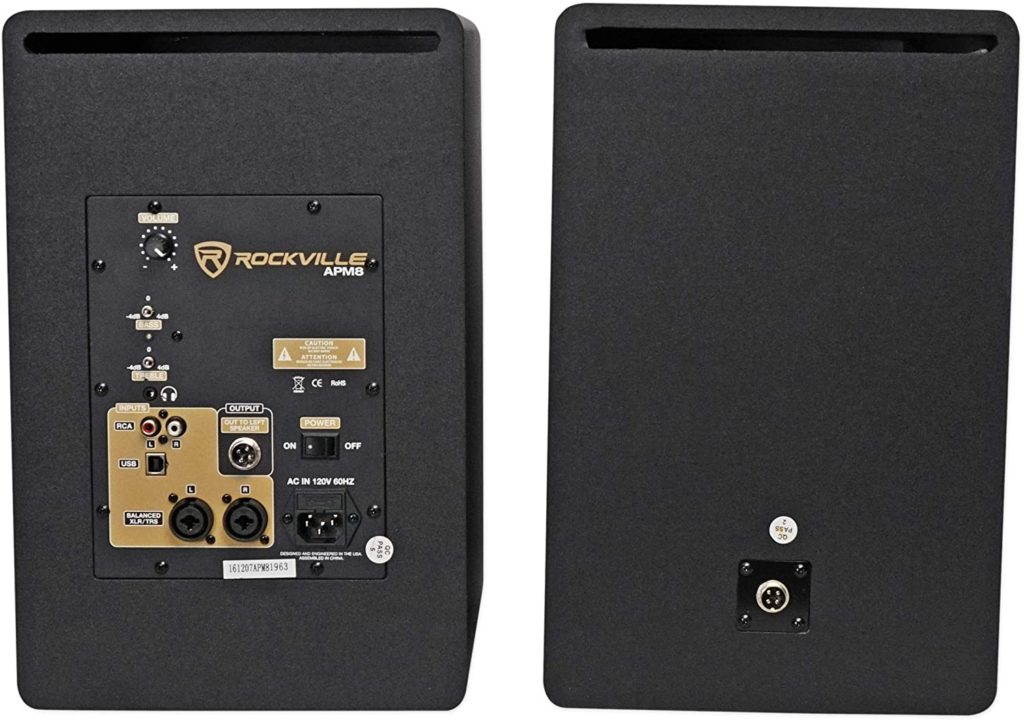
2.2 YAMAHA HS5
YAMAHA HS5 is also an active bi-amplified studio monitor. It may be a bit bigger than the average studio monitor, but these monitors are worth the price. Available in a white and black finish, it comes with a 5-inch woofer. The transducers and the amplifiers work together seamlessly producing a flat response.

The tweeter and woofer are provided with an exclusive amplifier for better performances. The controls include XLR, TRS inputs with audio interfaces, and keyboards. The low resonance enclosure design of the cabinet improves accuracy. The advanced noise reduction and updated transducers are the specialties of these monitors.
2.3 Mackie CR4
One of the best monitors for beginners, Mackie CR4, is the speaker that comes in grey color with a fluorescent green border. This speaker comes with a 0.75-inch tweeter and 4-inch woofer. It also has Bluetooth connectivity, an aux cord, cables, RCA cables, and a buffer stand. This speaker in a pug in play type of monitor which is convenient at times.
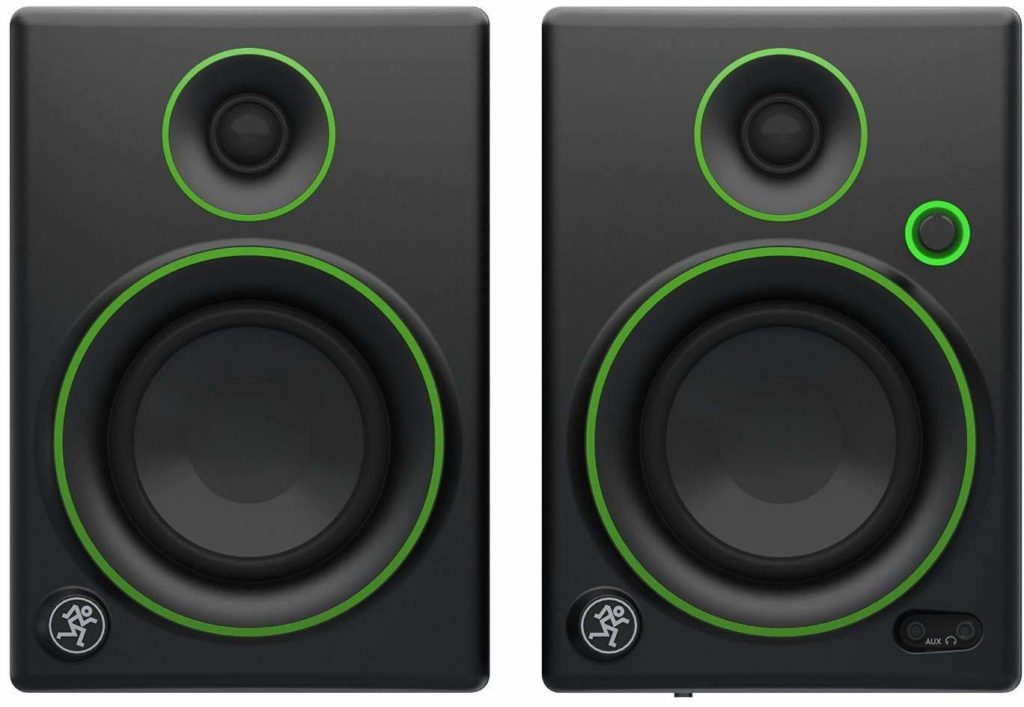
Lack of acoustic room controls is a con; however, with all the basic features it offers Mackie CR4 is the right choice. Even though this speaker does not guarantee a professional-level performance, but they promise to get your job done.
2.4 JBL Control 1 PRO (Best studio monitor with portable design)
JBL is a popular and widely-appreciated brand for its range of music-oriented products available on the market. JBL’s Control 1 Pro sports a 2-way speaker design that is enough to accommodate the needs of professional studio or home recordings.

Powered by magnetically shielded transducers, the monitor offers more comprehensive details and excellent dynamic range when using it close to monitor or TV applications.
2.5 KRK RP5 Rokit G4 (Best for audiophiles and professionals)
The KRK RP5 is a compelling and sturdy piece of listening gear for all things related to music production. Boasting of kevlar drivers, this studio monitor offers the exact sonic integrity, no matter what the frequencies the music is set.


Best Studio Monitors Under $100 (Budget Studio Monitors)
3.1 Presonus Eris E3.5 (Best compact under $100 studio monitor)
The Presonus Eris E3.5 has garnered positive reviews and the editor’s respect to deserve the number one spot under the $100 price range. Without much bells and whistles, this studio monitor quite effortlessly reproduces accurate and smooth sound quality.
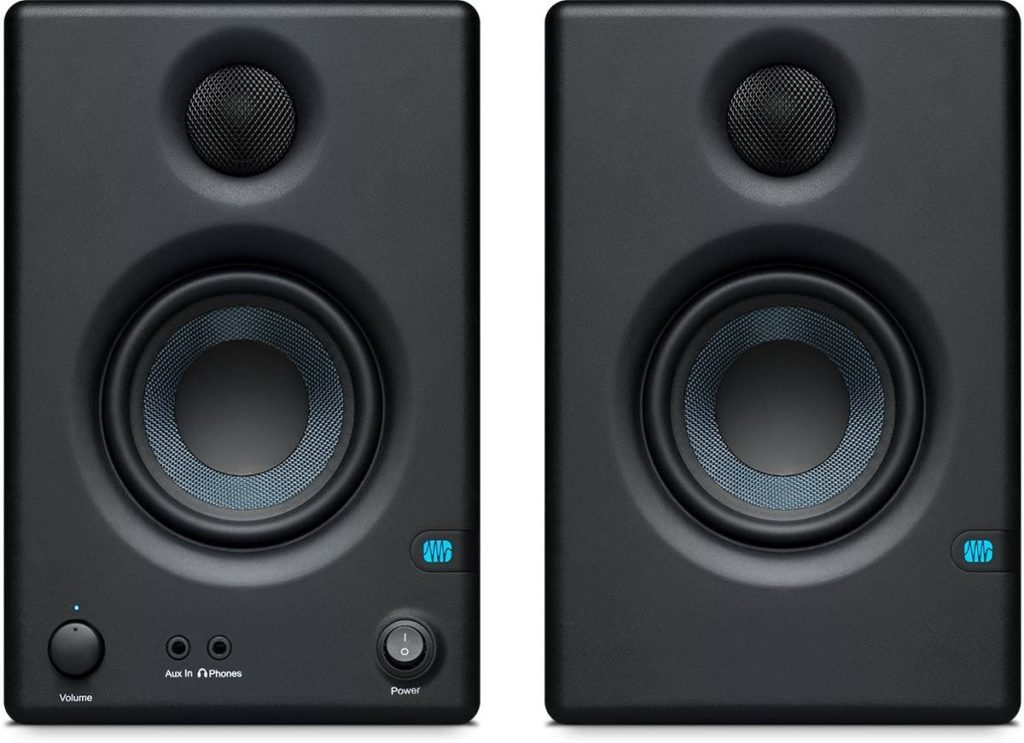
Supplied with 3.5 inch Kevlar and one-inch tweeters, music producers will be astonished to find something like this at an affordable price tag. The silk-dome tweeters ensure that you get to hear refined and super-smooth music.
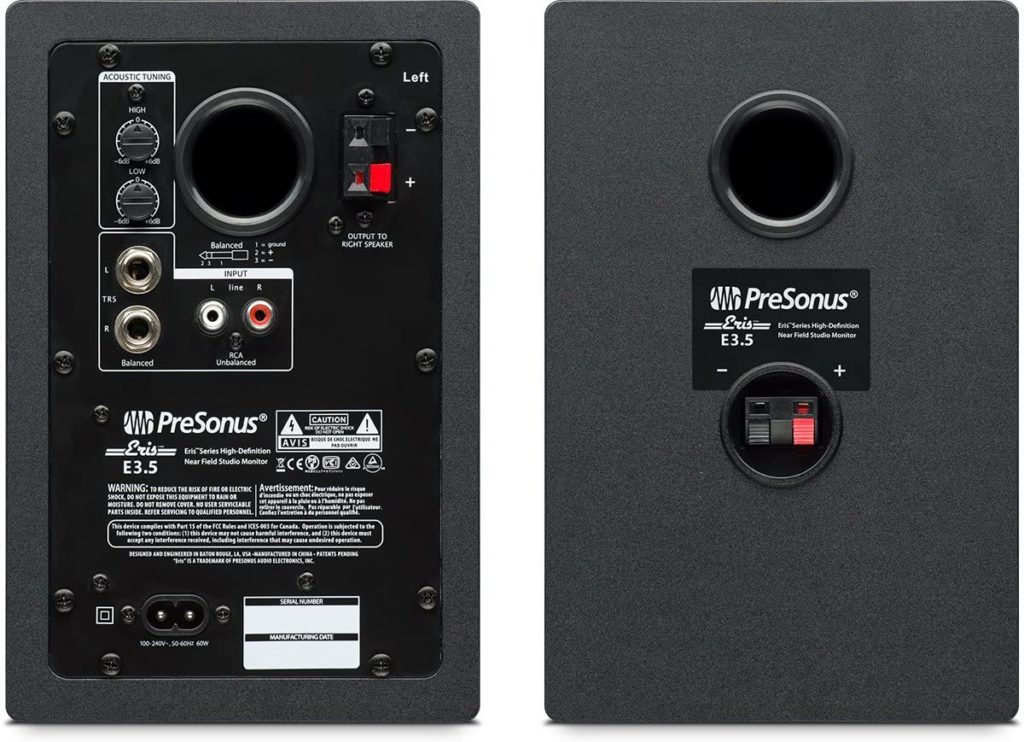
To easily have control over the music, the Eris E3.5 comes with a volume know and power buttons on the sides. The monitor has three different audio inputs, making it easier for you to connect multiple devices without a fuss.
3.2 Edifier R1280T (Best low-priced near field monitor)
Edifier is a brand that needs no introduction when talking about best-in-class speakers. Sporting an elegant wooden body, the R1280T is nothing less than a vintage speaker that oozes out incredible sound every time.

Furthermore, the monitor offers you to connect multiple audio devices with the dual RCA inputs. Additionally, you can also connect the monitor to your PC, laptop, phone, or tablet.
3.3 Behringer 1C-BK (Best inexpensive studio monitor)
The last one on the list of the best studio monitors is the Behringer 1C-BK. Coming in a very neat and bedazzling design, this studio monitor does pack a punch that too at a lower price than most high-end devices.
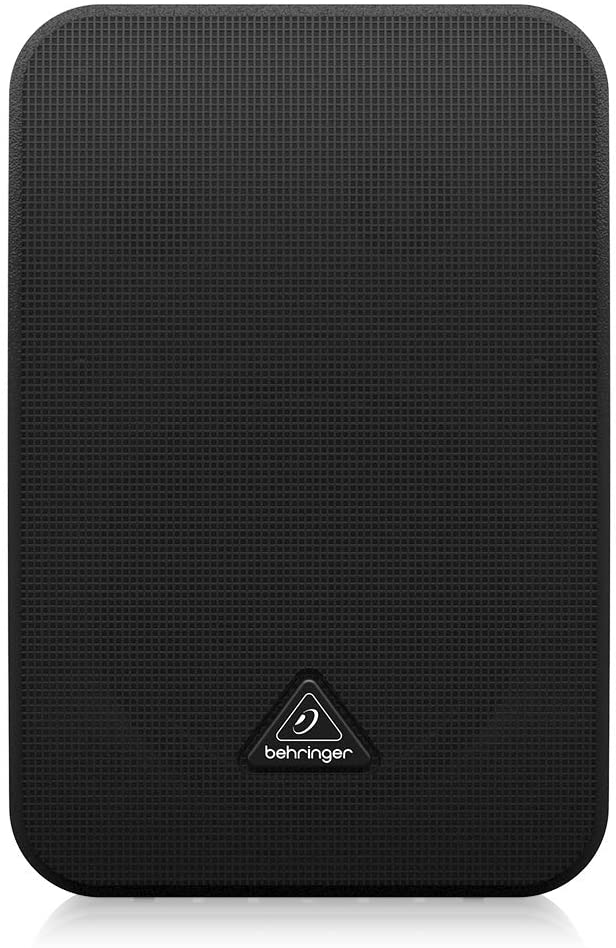

Things to keep in mind while setting up your studio monitors:
Setting up your studio monitor is as important as choosing the monitor. The whole work depends on the performance of the speaker, and the performance of the speaker depends on the placement of the monitor. Improper setup can mess up the recording even with the top monitors.
- Never go with the hyped sound– As mentioned before, most of the commercial speakers come with the boosted sound quality, which is more tempting than the studio monitors. These speakers already have accentuated bass frequencies that make the music to be brighter and punchier. Always go with the speakers that show what wrong with the recordings rather than the one which shows how good it sounds. The case with this kind of hyped speakers or modifications is that they may not sound the same outside the studio. The need for studio monitors is to produce the precise recording mix, which helps to listen to the specific elements of the mix critically.
- Place the speaker away from walls– There is this common tendency to keep the speakers against the wall for stronger bass. But this will have an adverse effect when coming to the low-end frequency adjustment. The bass response is not guaranteed to be precise, and the uneven frequency will be a threat to your creation. Most of the speakers are designed to produce an accurate and smooth response. Even without any enhancement, the monitors away from the walls can able to produce a crisp and particular frequency that assist you in balance and EQ adjustments.
- Strive for symmetry– While setting up the speakers, it is important that they are symmetrically placed. The walls and reflections of the room can cause variations in the sound that is produced. It is ideal to face the speakers towards you and to place your station somewhat middle of the room. By placing the speakers equidistant from the walls will help to have the same effects causing both the speakers and to have a balance in the recording. The positioning of the monitors should also form an equilateral triangle with your head. Keep all of them in mind for a high-quality outcome.
- The distance between the speakers– The distance between the speakers should not be so far or too close. The speakers must be 60 ̊ from each other or should form an equilateral triangle between you and the speakers (say, 30 ̊ from each side). Speakers placed too far causes distortion ending up the mix to be inappropriate. Same with the speakers placed too close; the recording may sound like the elements are bunched together, leaving you unable to benefit the stereo sound field. The recommended position will be 3 feet from the listener and each other. It also helps in reducing the effect of room reflections.
- Manage the effect from reflections– It is important to avoid all those strong reflections onto your workstation since these reflections can distort your playback. Everything in your room causes their portion of disturbance to your recordings. It may not be possible to avoid all those reflections but avoid them to the maximum extent. At least eliminate them from interrupting the space between the speakers and between the listener as well. Make sure your working environment will not cause any trouble in your work.
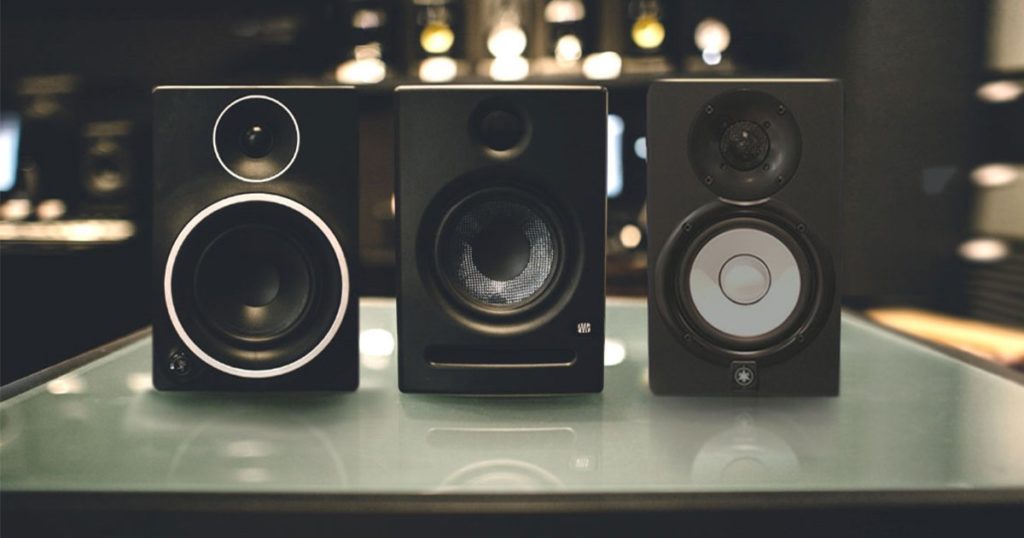
FAQs (Frequently Asked Questions)
-
What is the difference between speakers and professional studio monitors?
Studio monitors are designed to have a flat response with minimal distortion. They are more accurate and transparent, producing natural playback recording.
While consumer speakers are the ones seen in the home audio system. They have a shaped frequency response and have the setting for boosting the bass and frequencies for quality sounds. They come with their modification to produce a more appealing response.
2. What are the different parts of a studio monitor?
A studio monitor comes with components like a Tweeter (this takes care of treble response), an Amplifier, an Acoustic port (this helps in producing specific frequency response which helps the monitor to work efficiently), Woofer (this takes care of the bass response), and the cabinet (the body of the monitor).
3. What is the difference between an active and a passive studio monitors?
The main difference between these speakers in the amplifier. Active monitors come with an in-built power amplifier and passive speakers need an external power amplifier. Active monitors are mostly battery-powered and are easy to set up. Passive monitors are light and recommended for commuting. Since passive monitors don’t come with an amplifier, picking the right one can be a daunting task.
4. Is the studio monitor and loudspeaker the same?
No. Studio monitors are for producing accurate and exact playback without any coloration and perfect for critical listening. While loudspeakers are for high-power and distortion-free sound play, the quality for both the speaker response will be the same, but both the speakers are used for different purposes.
5. How do I connect my studio monitors?
Studio monitors are the most pivotal tools for nailing the art of audio recording and mixing. Quite like the standard speakers, studio monitors are also easy to set up. There are many things to consider when setting up a studio monitor.
- Connecting with laptop w/o interface: You need a 3.5mm jack to 2x XLR cable. Try using cable as long as possible. You will require two; one for each speaker. These cables can also be used in connecting DJ sets to active monitors.
- Connecting studio monitors to the audio interface: Find the right cables that are appropriate in length for maximizing the music experience. Keep the speakers in a symmetrical position. Ensure the distance of the speakers is the same on either side. The recommended angle is 60 degrees between the speakers and 30 degrees between each and the position of the listener.
To get the best out of studio monitors, the basic requirements are cables, connectors, and slots. Nevertheless, do not write off the importance of positioning the speakers accurately.
6. What is the ideal listening distance?
The ideal listening sweet spot recommended by experts is 1.75 m ~ 5.6 feet. According to ‘Audio Physic’, “The closer your listening position is to the loudspeakers, the lower the level of room-dependent sound production you will be exposed to.” However, the distance recommended has to be maintained so that the sound fields from the drives are added up accurately.
7. What are the important features to look for in-studio monitors?
There are a few essential factors to keep in mind before settling for a studio monitor. The following point might help you decide:
- Frequency Range: These denote the studio monitor’s capacity for handling music. The lowest range is identified as hertz (Hz) and the highest by kilohertz (kHz). The ideal range to consider in studio monitors is between 50 Hz and 20 kHz.
- Watts: This is handy, as a lot depends on the size of the space you are recording or listening to music. Depending on the size, choose the studio monitor. The smaller the room, the lower the power rating or watts. Similarly, the larger room, the higher the power rating monitor.
- Woofers and tweeters: These are the two of the most common parts of a studio monitor. The larger they are, the more effortlessly they can handle frequency. These come in different materials — carbon and fiber are best to consider for tweeters.
Our Final Thoughts
Before settling with your studio monitors, it is important to find your listening position. It is recommended to face the shortest wall and place your workstation symmetrically at the center. Remember to place the monitors on a stable platform eliminating the vibration from high-mass speakers.
When it comes to creativity, the quality of your studio monitors matters. You need to know the response the same way they are recording. Only with that kind of practice, you will know your work improvement. Make sure you are investing in the right monitor. The finest monitor gives you the finest work. You could use the Presonus Eris E4.5 if the budget is not the issue. If you’re in search of budget studio monitors, Edifier R1280T is one amazing device.
Was this article helpful for you? Did it cover all the important points and suggestions? We would like to know your feedback. Feel free to comment below.